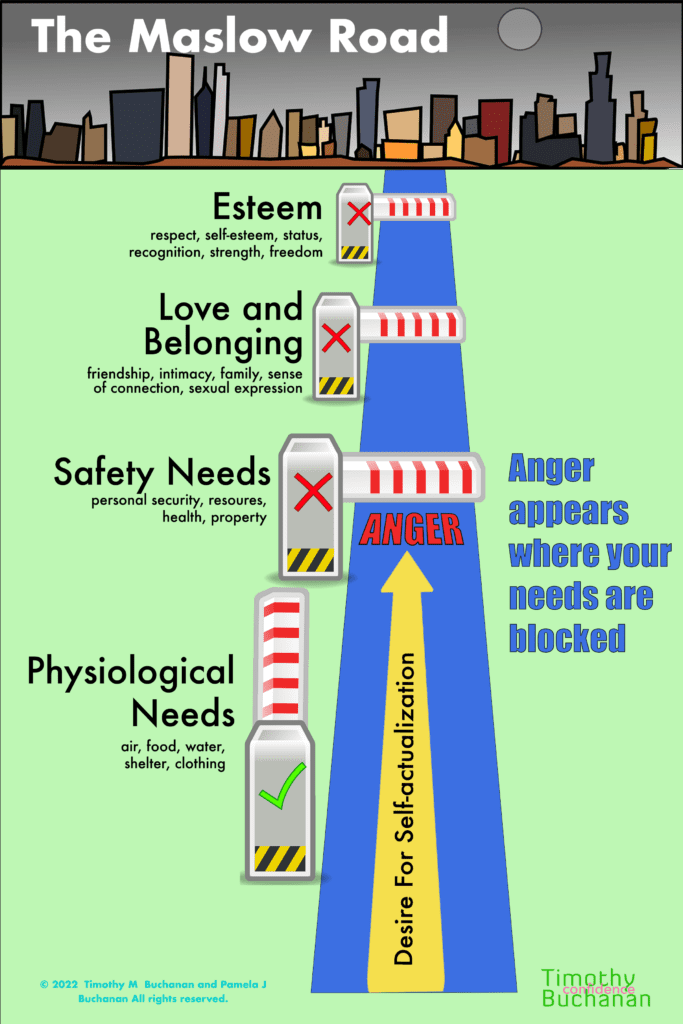
Have you ever felt that sudden surge of anger, seemingly out of nowhere, leaving you puzzled about its origin? Maybe you’ve seen it in someone else and it made you feel uncomfortable. What if this emotion, often avoided, dismissed or suppressed, is a guiding light into one’s deepest needs and desires? Delve with us into the intricate world of Maslow’s Hierarchy, uncovering the hidden paths we all tread upon, often unconsciously.
As we embark on this journey, you might just discover the secret roadblocks halting your own path, or someone else’s, to self-fulfillment and how to navigate them. Welcome to “Maslow’s Road” – a guide to understanding the very essence of our emotions.
In the vast landscape of human motivation, few theories are as renowned as Maslow’s Hierarchy of Needs. The pyramid, structured with physiological needs at its base and the pursuit of self-actualization at its peak, offers a profound insight into what drives us.
Now, imagine a road, taking you to a destination of self-actualization. This isn’t just any road, but a path that each of us walks daily, even if we’re unaware of it. Along this road, there are four major checkpoints: Physiological, Safety, Love and Belonging, and Esteem. These checkpoints are essential pit stops on our journey, places where we must find fulfillment before pushing onward.
However, life is not always smooth. Sometimes, there are blockages on our path, whether they’re physical barriers, emotional struggles, or psychological challenges. When we encounter these blockages, our journey toward self-actualization is halted. These disruptions can lead to feelings of anger and resistance. It’s essential to understand that whether these blockages are tangible (like actual deprivation) or merely perceived, our emotional and psychological response remains consistent: frustration, resistance, and often, anger.
Anger, frequently misunderstood, often surfaces as a control emotion. It’s our mind’s reflexive response when we feel life spiraling out of our grip, especially concerning our intrinsic needs. Maslow’s Hierarchy of Needs provides a roadmap to understanding the sources of such feelings of powerlessness. Let’s delve into how unfulfilled needs within this framework can manifest as anger.
Anger as a Response to Unmet Needs
Physiological Needs: These are the most fundamental of our needs. When they are threatened or unmet, we’re directly challenged at a survival level. Hunger, sleep deprivation, or other physiological deprivations can lead to a profound sense of powerlessness. Think of how irritability spikes when someone is referred to as ‘hangry’ (hungry + angry) or how fatigue intensifies emotional reactions.

Safety Needs: Feeling insecure or unsafe, whether in a physical or emotional context, can be destabilizing. The loss of control in ensuring personal safety can quickly spiral into anger. Someone may lash out if they perceive a threat, even if that threat is psychological, like job insecurity.
Love and Belonging Needs: Humans thrive on connection. When these relational needs are unmet, individuals may feel undervalued or rejected, leading to feelings of being out of control in their social ecosystem. A person might become confrontational after feeling excluded or not valued by peers or family.
Esteem Needs: Esteem and recognition are tied to our self-worth. A bruised ego or feeling underappreciated can trigger a sense of losing control over one’s standing in a community or group. Overreacting to feedback or becoming excessively competitive might be signals here.
Self-Actualization: Not realizing one’s potential or feeling barred from pursuing true passions can breed anger. This is about control over one’s destiny, and blockages here can feel like a tether holding one back. Signs might include resentment towards others who seem to be achieving their goals or a general bitterness about life’s direction.
Addressing Unmet Physiological Needs in the Workplace

In the hustle and bustle of the corporate world, it’s easy to overlook the fundamental physiological needs of employees. While the workplace might not be the first place that comes to mind when thinking of these needs, ensuring they are met is vital for maintaining productivity, morale, and overall well-being. Here’s a guide to recognizing these needs and addressing them effectively.
Warning Signs of Unmet Physiological Needs at Work
Chronic Fatigue: Employees regularly looking tired, yawning excessively, or reporting a lack of rest could be signals of improper sleep or overexertion.
Frequent Snacking or Skipping Meals: If you notice an employee constantly snacking or, conversely, skipping meals, they might not be getting proper nutrition during work hours.
Constant Thirst: An always-empty water bottle or frequent trips to the water cooler might indicate dehydration.
Complaints about Room Temperature: Continuous remarks about the office being too cold or too hot show discomfort due to inadequate shelter conditions.
Difficulty Concentrating: The lack of fresh air or proper ventilation can lead to employees having trouble focusing on their tasks.
Addressing Physiological Needs in the Workplace
Flexible Work Hours: Consider allowing flexible starting times or even remote work days. This can help employees maintain a healthy sleep schedule, especially if they have long commutes.
Provide Healthy Snacks: Stock the break room with nutritious snacks like fruits, nuts, and whole grains. Encourage employees to take regular meals and perhaps offer extended lunch breaks or an in-house cafeteria with balanced meal options.
Stay Hydrated: Ensure there are multiple hydration stations or water coolers around the workplace. Consider providing reusable water bottles as part of a wellness initiative.
Maintain Comfortable Working Conditions: Regularly check and maintain the office heating and cooling systems. Providing personal fans or heaters can also help employees adjust their immediate environment to their comfort.
Fresh Air and Breaks: Ensure the workspace is well-ventilated. Encourage employees to take short breaks, especially if they feel tired or unfocused. A short walk outside or even a few minutes by an open window can make a significant difference.
Ensuring Safety Needs in the Workplace: Recognizing the Signs and Taking Action

The workplace is more than just a space where employees come to work. It’s a microcosm where individuals seek not only professional but also personal fulfillment. An integral part of this fulfillment is the feeling of safety. Rooted in Maslow’s Hierarchy of Needs, the need for safety is foundational and paramount to ensure an environment where individuals can thrive. When this need is compromised, both productivity and morale suffer. This guide helps you recognize the warning signs of unmet safety needs and provides actionable ideas to address them.
Warning Signs of Unmet Safety Needs
Heightened Anxiety or Stress: If an employee often appears anxious, especially when executing certain tasks or during specific times, it might hint at an underlying safety concern.
Reluctance to Engage in Tasks: Refusing or hesitating to undertake particular jobs or projects can signal a feeling of insecurity or danger associated with that task.
Frequent Health Complaints: Continuous complaints about headaches, back pains, or other physical ailments might be linked to a compromised safety environment.
Increased Absenteeism: Employees taking frequent off-days or extended leaves might be doing so to avoid an environment they perceive as unsafe.
Isolation from Teams: Employees distancing themselves from group tasks or avoiding social interactions might be doing so out of fear or lack of trust.
Addressing Safety Needs in the Workplace
Risk Assessments: Regularly conduct risk assessments to identify potential safety hazards. These could range from unsafe equipment to threats of workplace harassment.
Safety Training: Organize frequent safety training sessions, ensuring every employee knows how to handle equipment correctly, what to do in emergencies, and where to report safety concerns.
Clear Communication Channels: Establish transparent communication channels where employees can report their concerns without fear of retaliation. This could be through a designated HR representative or anonymous reporting tools.
Establish a Wellness Program: Incorporate wellness programs that address both physical and mental health. Activities like mindfulness sessions, ergonomic workshops, and counseling can help in reducing stress and anxiety.
Strengthen Security Measures: If safety concerns stem from external threats, consider beefing up security. This could mean better surveillance systems, secure access points, or even hiring security personnel.
Promote a Culture of Trust and Openness: Foster a workplace environment where employees feel they can openly share their concerns and trust that they will be addressed appropriately.
Belonging in the Workplace: Recognizing the Signs and Nurturing Inclusivity

The foundation of a thriving and engaged workplace is often built upon the relationships and connections among its members. Rooted in Maslow’s Hierarchy of Needs, the concept of ‘love and belonging’ speaks to the inherent human desire to be part of a community and to feel connected to others. While the workplace is primarily a professional setting, the emotional and social needs of employees cannot be overlooked. Understanding the warning signs of unmet love and belonging needs and taking steps to foster them can create a healthier and more motivated workforce.
Warning Signs of Unmet Belonging Needs
Withdrawal from Social Interactions: Employees who consistently avoid group lunches, team meetings, or other group activities may be feeling isolated.
Decreased Participation in Discussions: Silence during team meetings or a lack of contribution to group projects can signal feelings of detachment.
Excessive Emotional Responses: Overreacting to feedback or misinterpreting neutral comments as negative can be an indicator of a deeper need for validation.
Reluctance to Collaborate: Preferring to work alone, even when collaboration could be more effective, might suggest an employee doesn’t feel part of the team.
Frequent Sick Days or Late Arrivals: Consistently showing up late or taking time off could be an attempt to minimize time spent in an environment where they feel they don’t belong.
Promoting Belonging in the Workplace

Team Building Activities: Regular team-building sessions, both formal and informal, can help members get to know each other beyond their professional roles, fostering understanding and camaraderie.
Open Communication: Encourage open dialogue, where employees can share concerns or feelings without fear of judgment or retribution.
Mentorship Programs: Pairing newer employees with seasoned ones can help them feel connected and provide a go-to person for advice and guidance.
Celebrating Milestones: Recognizing birthdays, work anniversaries, and personal achievements can make employees feel valued and included.
Feedback Loops: Regular check-ins or surveys to understand employee sentiments can give insight into how they feel about their place within the organization.
Inclusive Policies: Ensure that company policies promote diversity and inclusivity. This can be in the form of diverse hiring practices, celebrating multicultural events, or even ensuring that company social activities cater to various interests and preferences.
Seeking Esteem in the Workplace: How to Spot the Signs and Elevate Employee Morale
Esteem, as defined by Abraham Maslow’s Hierarchy of Needs, is the human desire to be respected by peers, feel valued, and have self-worth. In a professional setting, when esteem needs aren’t met, it can result in decreased productivity, higher turnover, and even workplace conflicts. Recognizing the signs and implementing strategies to address these needs can foster a positive work environment where every individual feels valued.
Warning Signs of Unmet Esteem Needs
Decreased Productivity: An employee might exhibit a drop in work quality or completion, possibly feeling that their efforts aren’t recognized or valued.
Reluctance to Share Ideas: If employees feel their contributions are consistently undervalued or ignored, they may stop offering new ideas or solutions.
Overcompensation: In an attempt to prove their worth, some might take on excessive work, leading to burnout or mistakes due to overload.
Increased Sensitivity: Employees might appear overly sensitive to feedback, taking even constructive criticism personally.
Isolation from Colleagues: A person feeling undervalued might distance themselves from colleagues, avoiding group lunches or team gatherings.
Seeking External Validation: If esteem needs aren’t met in the workplace, an employee might frequently mention praise or recognition received outside of work.
Addressing Esteem Needs in the Workplace
Regular Recognition: Implementing a system of regular recognition, be it weekly shout-outs, monthly awards, or yearly bonuses, can make employees feel valued.
Open Feedback Channels: Ensure there are mechanisms in place where employees can voice concerns, share achievements, and seek feedback.
Skill Development Opportunities: Offering workshops, courses, or tools that allow employees to enhance their skills can boost their confidence and sense of worth.
Mentorship Programs: Being mentored can help employees feel valued and invested in. Conversely, being a mentor can boost self-worth and provide recognition of one’s skills and contributions.
Encourage Peer Recognition: Create a platform where team members can appreciate and acknowledge their colleagues’ contributions. Peer recognition can sometimes hold more weight than managerial praise.
Clear Job Roles and Expectations: Ensure that every employee has a clear understanding of their role, its importance, and how it contributes to the organization’s goals.
Promote a Collaborative Environment: Encourage team projects and collaboration which can help individuals feel their strengths are recognized and valued within a team context.
Chasing Potential: Recognizing and Fulfilling Self-Actualization Needs in the Workplace

At the pinnacle of Maslow’s Hierarchy of Needs stands self-actualization, the quest to achieve one’s potential and realize one’s abilities to the fullest extent. While this is a deeply personal journey, the workplace plays a significant role in either fostering or hindering this pursuit. When employees’ self-actualization needs aren’t being addressed, it can manifest in various ways that can be detrimental to both the individual and the organization. Recognizing the signs and taking measures to promote self-actualization can be transformative for the workplace culture.
Warning Signs of Unmet Self-Actualization Needs
Lack of Enthusiasm: An evident disinterest in tasks, even those that once were a source of passion, can be a sign of unmet self-actualization needs.
Stagnation in Role: If an employee is not seeking or receiving opportunities for growth, they might feel stuck in their current position.
Decreased Creativity: A decline in innovative ideas or solutions may indicate that an employee doesn’t feel their creative potential is being realized.
Avoidance of Challenges: Those who don’t see an opportunity to grow might shy away from challenges or new responsibilities.
Disengagement: A general sense of detachment or indifference towards projects or team goals can signify a deeper struggle with finding purpose in their role.
Expressed Frustration: Vocal frustrations about not being able to pursue new avenues, projects, or skills might be an outcry for the need for self-actualization.
Encouraging Self-Actualization in the Workplace
Opportunities for Growth: Provide continuous learning opportunities, workshops, or courses that allow employees to expand their skill set.
Flexibility in Roles: Allow employees some autonomy to shape their roles, take on projects that align with their passions, or shift between teams.
Encourage Creativity: Create an environment where innovative ideas are celebrated. Organize brainstorming sessions, workshops, or ‘innovation days’ where employees can work on passion projects.
Set Clear Paths for Advancement: Ensure there’s transparency in how employees can progress in their careers within the organization.
Feedback and Recognition: Regularly provide feedback, acknowledging the unique strengths and talents of each employee. Recognize their achievements and contributions.
Mentorship and Coaching: Offer mentoring programs where employees can seek guidance, gain insights, and be inspired to pursue their professional aspirations.
Promote Work-Life Balance: Encourage a balanced life where employees can pursue passions outside of work, which can often feed back into their professional self-actualization.
Empowering a Holistic Work Environment:

Throughout our exploration of Maslow’s Hierarchy of Needs – from the foundational physiological needs to the aspirational quest for self-actualization – we’ve highlighted the crucial signs that cause anger and indicate when these needs might be falling short in your workplace. Ignoring these signs doesn’t just threaten individual well-being; it risks undermining team cohesion, productivity, and the broader vibrancy of your organization. However, you’re far from powerless in this situation. You have the transformative power to pivot and make impactful changes.
We Can Help
Our training series on “Value, People, and Purpose” provides a structured roadmap to guide you on this transformative journey. Embracing its insights can be the catalyst for crafting a work environment that’s not only inclusive and encouraging but also astutely attuned to meeting the multifaceted needs of its members. Implementing such a culture is not a mere business strategy; it’s a moral imperative and a hallmark of visionary leadership.
Taking proactive steps to understand and cater to these needs is an affirmation of an organization’s genuine commitment to its greatest asset – its people. As you stand at this juncture, consider this: the future of work is not merely about balance sheets and profit margins. It’s a resonant tapestry woven from the threads of Values, Purpose, and the undeniable worth of every individual.
It’s time to evolve and elevate. With our “Value, People, and Purpose” training series as your ally, you’re primed to foster an environment where every individual thrives, feels valued, and is driven to reach their fullest potential. The future beckons, one where profit aligns seamlessly with people-centric values. Your transformative journey begins today. Are you ready to lead the charge? Give us a call.
